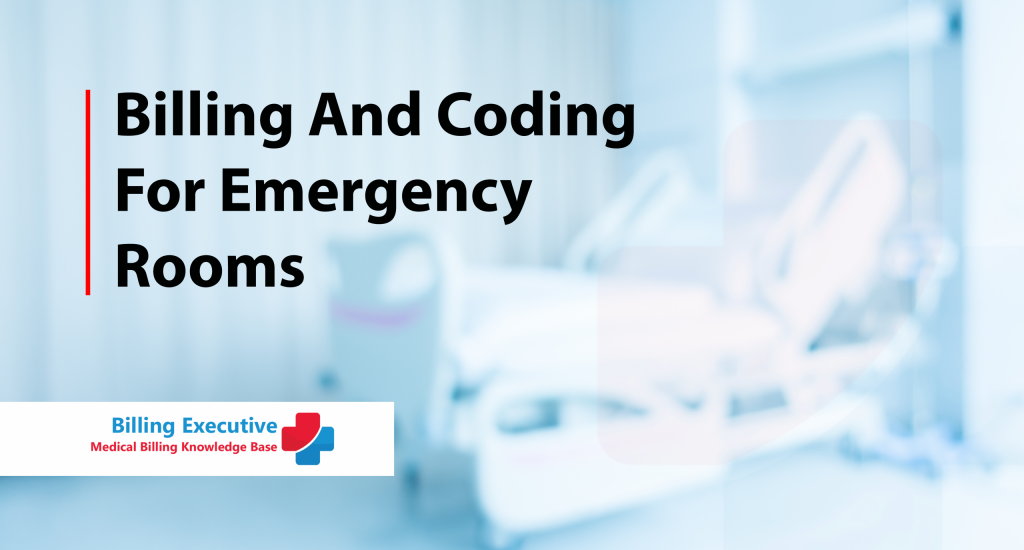A hospital room is staffed and prepared to receive and treat patients who require emergency medical attention. It is a medical treatment centre specializing in emergency medicine or the acute care of patients who arrive without an appointment, either independently or through an ambulance. The emergency department is often located in a hospital or other primary care facility. It is also known as an A&E department, an emergency department (ED), an emergency ward (EW), or a casualty department.

The Centre for Medicare and Medicaid Services (CMS) categorized emergency departments into two types:
Type A: Those that are open 24/7 the whole year.
Type B: Those that remain less active than type A are classified as type B emergency departments.
Many emergency rooms in the United States are quite crowded.
Coding & Billing Guidelines
Emergency Department (ED) Evaluation and Management (E/M) codes are typically reported daily and do not differentiate between new or established patients. There are five levels of emergency department services represented by 99281 – 99285 CPT codes.
The ED codes require all three following vital components to be met and documented for the level of service selected.
- History
- Examination
- Medical decision-making.
CPT Codes For Emergency Rooms
The American Medical Association maintains the Current Procedural Terminology (CPT) code range from 99281-99288 for Emergency Department Services.
The level of service invoiced must be based on the intervention(s) conducted in connection to the medical treatment required by the patient’s presenting symptoms and resulting in a diagnosis. Professional codes are based on the intricacy of the task performed, which involves “mental” effort. The facility codes represent the volume and intensity of resources employed to provide care by the facility.
The provider’s medical records and paperwork may be asked to substantiate the amount of treatment provided. The documentation must identify and support the billable ED E/M codes. The appeal request must provide supporting documents if a refusal is appealed.
CPT Code 99281:
This CPT code includes patients’ visits to the emergency department for the assessment and care that consists of the following three critical components:
- Problem-focused history.
- Problem-focused examination.
- Straightforward medical decision making.
Counselling and coordination of treatment with other providers or agencies are offered under the nature of the problem(s) and the requirements of the patient and family. The presenting problem(s) are usually self-limited or minor that do not require drugs or home therapy.
e.g., The signs and symptoms of wound infection are described; return to the ED if issues arise.
CPT Code 99282:
A visit to the emergency department for the examination and care of a patient comprises three (3) critical components:
- More extensive problem-focused history
- Extensive problem-solving investigation
- Low-complexity medical decision-making
The problem(s) reported range from low to moderate severity.
e.g., Over-the-counter (OTC) drugs or therapy, easy dressing changes
CPT Code 99283:
Emergency department visit for patient evaluation and care requires the following three critical components:
- Enlarged problem-focused history
- Expanded problem-focused examination
- Moderate-complexity medical decision making
Coordination of treatment with other providers or agencies is offered under the nature of the problem(s) and the requirements of the patient and family. The presenting problem(s) are usually of moderate intensity.
e.g., Instructions for a head injury, crutch training, bending, lifting, weight-bearing restrictions, and prescription medicine with a summary of side effects and probable bad reactions.
CPT Code 99284:
An emergency department visit is required to examine and care a patient, which necessitates using these three critical components.
- A thorough history
- A thorough investigation
- Moderately complicated medical decision making
The problem(s) reported are highly severe and require prompt medical attention, but they do not constitute an immediate severe threat to life or physiologic function.
e.g., Instructions for a head injury, crutch training, bending, lifting, weight-bearing limitations, prescription medication with a review of side effects and potential adverse reactions; the patient may have questions but otherwise demonstrates adequate understanding of instructions either verbally or by the presentation.
CPT code 99285:
This Cpt code deals with an emergency department visit for the examination and care of a patient, which necessitates the following three critical components within the restrictions given by the patient’s clinical state and mental status:
- A thorough history
- A thorough examination
- High-level medical decision-making.
Counselling or coordination of treatment with other providers is offered under the nature of the problem(s) and the requirements of the patient and family. Typically, the presenting pain (s) is severe and represents an immediate serious threat to life or physiologic function.
e.g., Multiple prescription medications and home therapies, including assessing side effects and potentially severe complications; diabetic, seizure, or asthma education is compromised or non-compliant patients; patient/caregiver may have difficulties comprehending instructions and require additional directions to complement compliance with recommended medication.
About us
Billing Executive – a Medical Billing and Coding Knowledge Base for Physicians, Office staff, Medical Billers and Coders, including resources pertaining to HCPCS Codes, CPT Codes, ICD-10 billing codes, Modifiers, POS Codes, Revenue Codes, Billing Errors, Denials and Rejections.
We have more than 10 years experience in US Medical Billing and hand-on experience in Web Management, SEO, Content Marketing & Business Development with Research as a special forte.
Learn More
The No Surprises Act (NSA) and What It Means for Emergency Rooms
Medical Coding: The Key to Minimizing Administrative Costs and Eliminating Claims Denials
Updated List of Freestanding Emergency Rooms in Texas
CO 40 Denial Code: Why Insurance deny Emergency Room claims?
